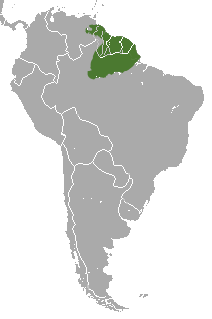White-faced saki
| White-faced saki[1] | |
|---|---|
 | |
| Male White-faced Saki (Pithecia pithecia) | |
.jpg) | |
| Female White-faced Saki (Pithecia pithecia) | |
| Conservation status | |
| Scientific classification | |
| Kingdom: | Animalia |
| Phylum: | Chordata |
| Class: | Mammalia |
| Order: | Primates |
| Family: | Pitheciidae |
| Subfamily: | Pitheciinae |
| Genus: | Pithecia |
| Species: | P. pithecia |
| Binomial name | |
| Pithecia pithecia (Linnaeus, 1766) | |
 | |
| White-faced Saki range | |
The white-faced saki (Pithecia pithecia), also known as the Guianan saki and the golden-faced saki, is a species of saki monkey, a type of New World monkey, found in Brazil, French Guiana, Guyana, Suriname and Venezuela. This species lives in the understory and lower canopy of the forest, feeding mostly on fruits, but also eating nuts, seeds, and insects.
There are two recognized subspecies of this monkey:
- Pithecia pithecia pithecia
- Pithecia pithecia chrysocephala
Reproduction

Sakis of the Pithecia pithecia species display noticeable sexual dichromism in their coloration. Females have shorter hair than males, with brownish-grey fur and white or pale brown stripes around the corners of the nose and mouth. Males, on the other hand, have blacker fur, with a reddish-white forehead, face, and throat.[4]
Behavior
A pair often mates for life. They are very devoted and will strengthen their bond by grooming one another.
References
- ↑ Groves, C. P. (2005). Wilson, D. E.; Reeder, D. M, eds. Mammal Species of the World (3rd ed.). Baltimore: Johns Hopkins University Press. p. 148. OCLC 62265494. ISBN 0-801-88221-4.
- ↑ Veiga, L. M. & Marsh, L. (2008). Pithecia pithecia. In: IUCN 2008. IUCN Red List of Threatened Species. Retrieved 3 January 2009.
- ↑ Savage, A., et al. (1995). Selected aspects of female white-faced saki (Pithecia pithecia) reproductive biology in captivity. Zoo Biology, 14(5), 441–452. Retrieved 8 July 2008, from Wiley InterScience Journals database. doi:10.1002/zoo.1430140506.
- ↑ Sakis Pithecia. (23 Feb 2004). Retrieved 8 July 2008, from Mark V. Flinn, Dept. of Anthropology, University of Missouri-Columbia
External links
| Wikimedia Commons has media related to Pithecia pithecia. |
| Wikispecies has information related to: White-faced Saki |
| ||||||||||||||||||||||||
